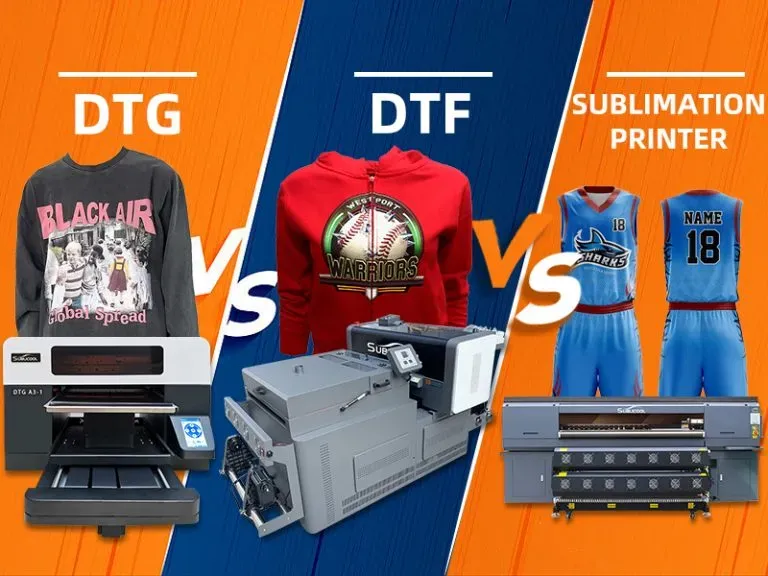When comparing DTF vs. DTG printing, the differences between these two innovative fabric printing methods become crucial for businesses seeking quality and efficiency. Direct-to-Film (DTF) printing allows for vibrant colors and versatility across various fabric types, while Direct-to-Garment (DTG) printing excels in producing intricate designs with stunning detail, perfect for cotton materials. This article offers an insightful printing technology comparison that delves into the strengths and weaknesses of each method, helping professionals understand which suits their needs best. By exploring key factors such as print quality, fabric compatibility, and cost-efficiency, we aim to provide a comprehensive guide to these popular fabric printing methods. Whether you’re a small business owner or a seasoned print professional, grasping the nuances of DTF vs. DTG printing will empower you to make informed decisions in your printing endeavors.
In the world of fabric printing, the choice between Direct-to-Film (DTF) and Direct-to-Garment (DTG) methods can significantly influence outcomes for designers and businesses alike. DTF printing, also known as transfer printing, revitalizes designs through a heat transfer process, enabling bold colors on various textiles. Conversely, DTG printing harnesses advanced inkjet technology to create lifelike, detailed images directly on garment fabric, predominantly cotton. This discussion introduces a comparative analysis of these high-demand fabric printing techniques, highlighting their unique capabilities and ideal use cases. Understanding the distinctions between these fabric printing alternatives is essential for selecting the best solution tailored to creative and commercial printing projects.
Understanding DTF Printing: A Modern Fabric Technology
Direct-to-Film (DTF) printing has revolutionized the fabric printing industry with its innovative approach to transferring designs onto a variety of materials. Unlike traditional methods, DTF utilizes a special film that is coated with a unique adhesive powder after the design is printed. This process allows for vibrant and detailed prints, especially on darker fabrics, where the use of white ink enhances visibility and color richness. As a result, designers and brands can push creative boundaries, producing complex and colorful designs that stand out in the market.
Additionally, DTF printing accommodates a wide range of fabrics beyond just cotton, including polyester blends and even non-woven materials. This broad compatibility means that brands can explore new creative avenues, producing everything from sports apparel to specialized fashion pieces. Furthermore, the durability of prints produced through DTF methods ensures that the colorful designs withstand repeated washes without fading, making this method a compelling option for both designers and consumers alike.
Frequently Asked Questions
What are the main differences between DTF printing and DTG printing?
The main differences between DTF (Direct-to-Film) printing and DTG (Direct-to-Garment) printing lie in their printing processes and fabric compatibility. DTF printing involves transferring designs printed on a special film to the fabric using heat, allowing for vibrant colors even on dark fabrics. In contrast, DTG printing directly applies ink onto the fabric, producing intricate designs best suited for cotton fabrics.
Which is more cost-effective: DTF printing or DTG printing?
DTF printing is generally more cost-effective for bulk orders as it allows multiple designs to be printed on one film, leading to higher output. On the other hand, DTG printing, while delivering excellent quality, often incurs higher setup costs, making it better suited for smaller runs with customized designs.
Is DTF printing suitable for all types of fabrics compared to DTG printing?
Yes, DTF printing is more versatile and can be used on a broad range of fabrics, including cotton blends, polyester, and non-woven materials. In contrast, DTG printing primarily works on 100% cotton or cotton blends, which limits its fabric compatibility.
How does print quality differ between DTF and DTG printing methods?
DTF printing is recognized for its vibrant color reproduction and durability, especially on dark fabrics due to its use of white ink. DTG printing, however, excels in producing detailed prints and color gradients, making it ideal for light-colored fabrics but may not perform as well on darker backgrounds.
What types of businesses benefit more from DTF vs. DTG printing?
Businesses focused on high-volume production with diverse designs will benefit from DTF printing due to its cost-efficiency. Conversely, businesses that aim for high-quality, intricate designs on cotton or cotton blends may find DTG printing more suitable for their needs.
What are the recent advancements in DTF and DTG printing technologies?
Recent advancements in DTF include the launch of user-friendly printers like the XTF Pro, enhancing automation and accessibility for small businesses. In DTG, ongoing innovations continue to improve quality and efficiency for intricate designs, keeping both technologies competitive in the printing market.
| Aspect | DTF Printing | DTG Printing |
|---|---|---|
| Technology and Process | Involves printing on film and heat transfer, allows vibrant colors on dark fabrics. | Direct application of ink onto fabric, best for detailed designs. |
| Fabric Compatibility | Works on a variety of fabrics including blends and non-woven materials. | Best suited for 100% cotton or cotton blend fabrics. |
| Print Quality | Known for vibrant colors and durability; excels on dark fabrics due to white ink use. | Excels at detailed prints and color gradients, optimal on light fabrics. |
| Cost-Efficiency | More cost-effective for bulk orders with high output. | Higher initial costs, ideal for small to medium runs. |
Summary
In the discussion of DTF vs. DTG printing methods, it’s clear that both offer unique advantages tailored to different production needs. DTF printing is characterized by its versatility and cost-effectiveness, making it ideal for high-volume productions across various fabric types. Conversely, DTG printing shines with its ability to produce intricate and detailed designs, particularly on cotton materials. As businesses evaluate their options, understanding the nuances of DTF vs. DTG will guide them toward making informed choices that enhance their printing capabilities and meet customer expectations.



